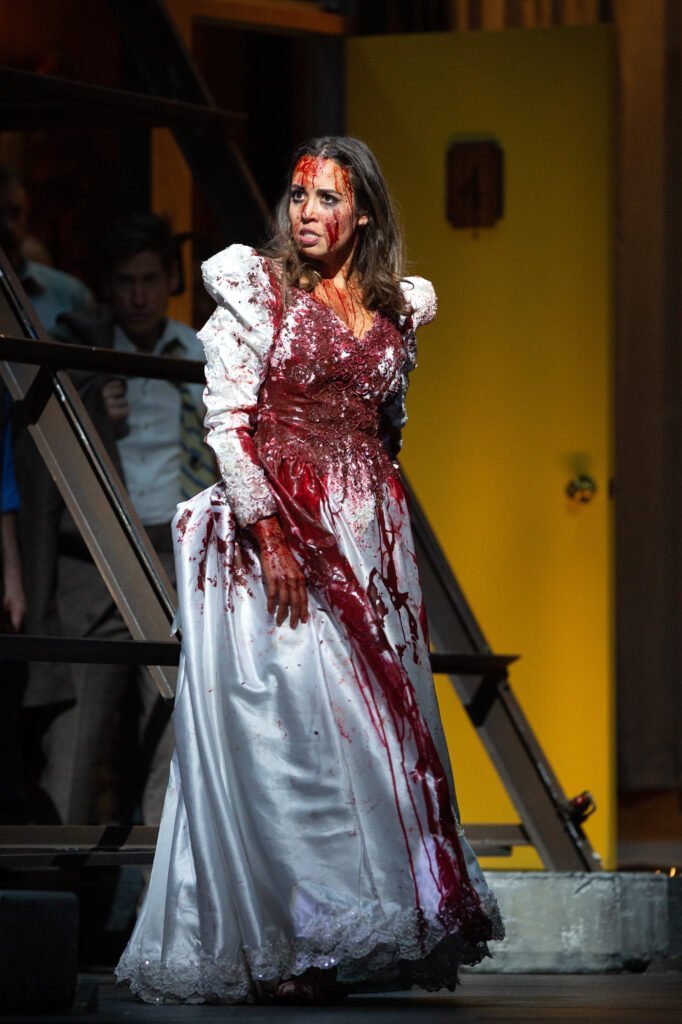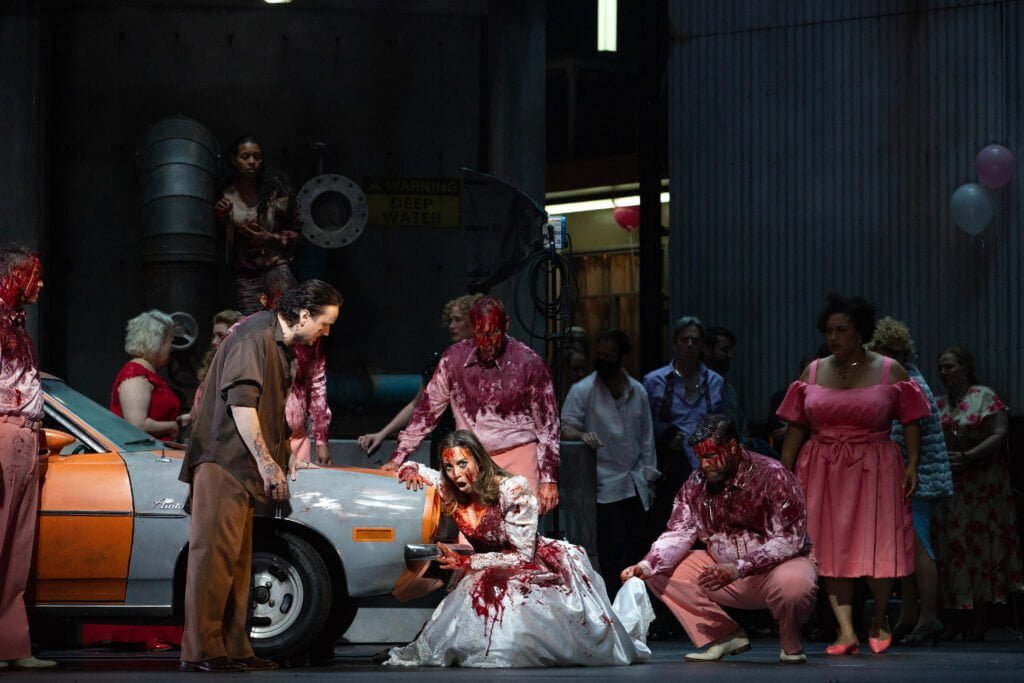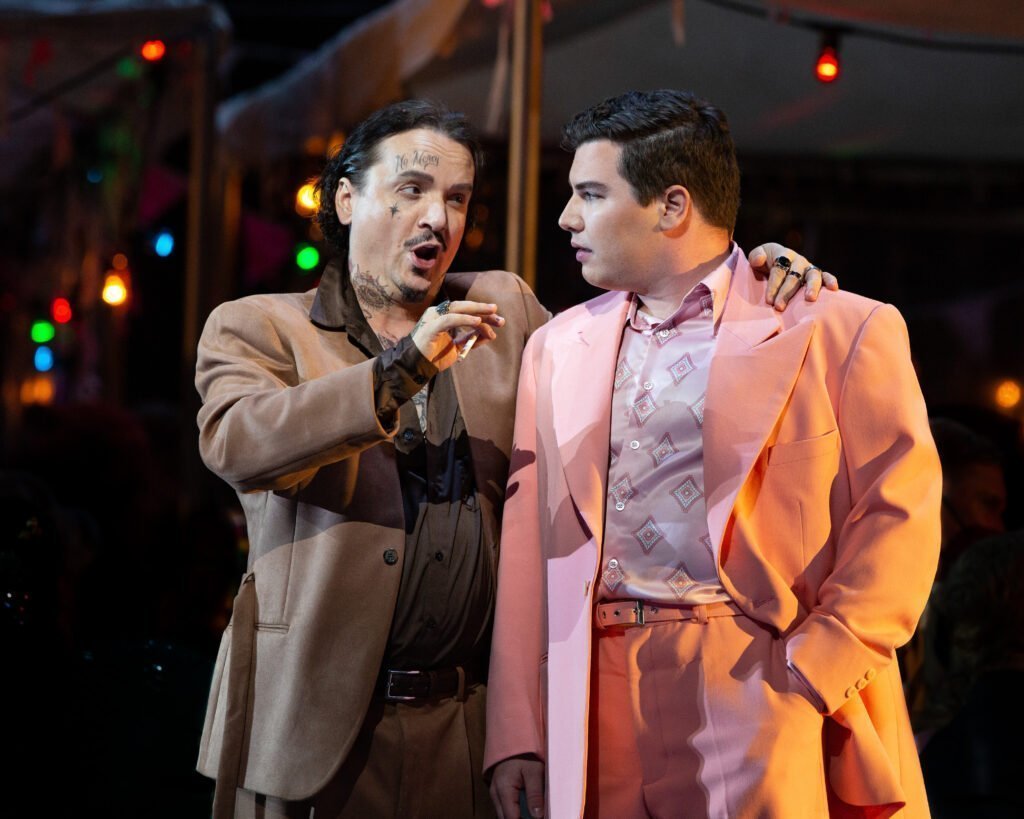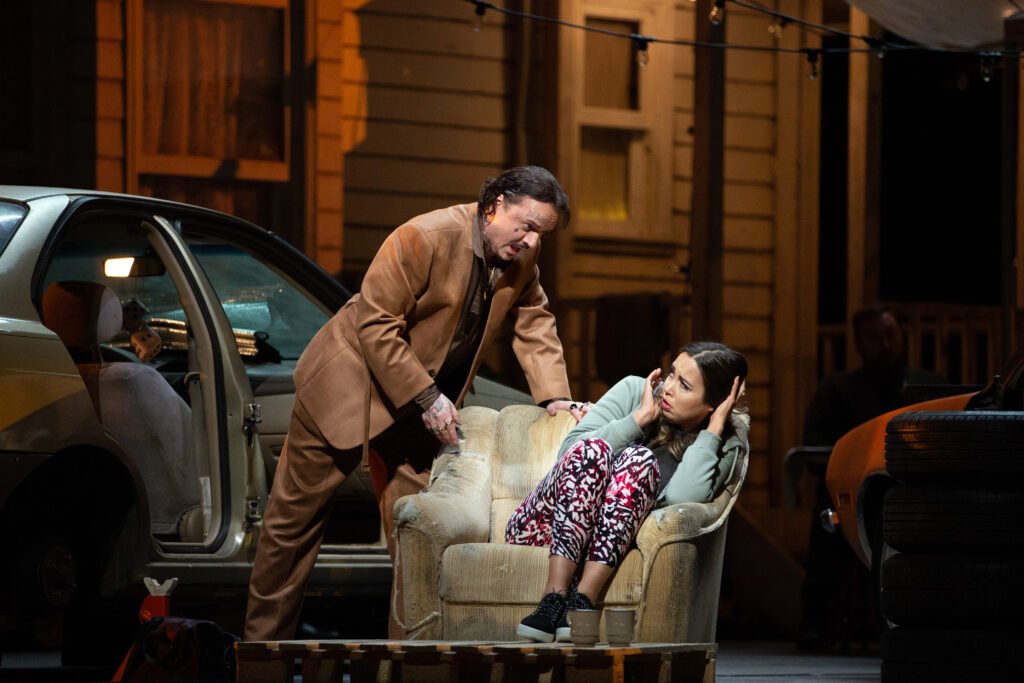Lucia di Lammermoor by Gaetano Donizetti. Dramma tragico in three acts. 1835. Libretto by Salvadore Cammarano, after Sir Walter Scott’s novel The Bride of Lammermoor. First performance at the Teatro S Carlo, Naples, on 26th September 1835. Attended: 26th April 2022. MET, New York.
CONDUCTOR Riccardo Frizza; LUCIA Nadine Sierra; EDGARDO Javier Camarena; ENRICO Artur Ruciński; RAIMONDO Matthew Rose; The Metropolitan Opera Orchestra and Chorus
Attended by Robert Levine for Opera Gazet, 26 April, 2022
Drunken Brawls, Tasteless Clothing and Brutality – White-Trash “Lucia”
Music: 5*****
Drama: 1*
Offensive drabness
Well, it was bound to happen. Twenty-or-so years ago, when we New Yorkers read about Calixto Bieito’s production of Un ballo in Maschera for the Liceu in which the opening chorus featured men sitting on toilets, we felt certain that the conservative, traditional Met would never have to tolerate such junk. Then, in 2011, a new production of Gounod’s Faust was set right before World War II. Faust was a scientist working on the Atom Bomb; at the opera’s end the bomb detonates after Marguerite has walked up a staircase and disappeared.
But with the Met’s new Lucia di Lammermoor, we enter a new phase. The curtain rises and we see that we are re-located from late 18th century Scotland to a poor, wrecked mess of a town in what is sometimes called the “Rust Belt,” somewhere in the east or mid-west of the United States which fell into disrepair in the 1980s when the coal and steel industries that kept them alive either collapsed or re-located. This contemporary concept – the characters have cell phones – is by first-time Met director Simon Stone. The costumes by Alice Babidge and Blanca Anon feature skintight jeans and midriff-baring spangly top for Lucia, and a panoply of cheap-looking clothing for the rest – shocking pink and glittery green dresses, sloppy pants, work-clothes.
The constantly revolving set by Lizzie Clachan, consists of a pawn shop, a cheap motel, a tacky drive-thru pharmacy (at which, I believe, Lucia collects her methadone), the house in which Lucia and her brother live with a small front porch strewn with empty bottles and old living room furniture, an ATM machine, a food mart where Edgardo works (though he’s also a soldier on reserve), a water treatment plant in lieu of a fountain in a park (where Lucia recalls watching a girl die of a stomach wound, and who returns during her Mad Scene to haunt her), a blue, dented pick-up truck and three-or-so other battered vehicles with (oddly) their lights on, and – wait for it – a drive-in movie theater playing a 1947 Bob Hope – Dorothy Lamour film. The Wolf’s Crag scene and Ravenswood Cemetery are on the same ugly turntable. After you’ve seen all of these components spin around once and you marvel at the ingenuity of it all, you simply tire of its offensive drabness. Or you may be dazzled by the trashiness of it all. Lammermoor never looked so lousy.

Bashing Arturo’s head in with a fire extinguisher
But there’s more: the top half of the proscenium is taken up with a screen showing us either Lucia being followed around by a cameraman in real time, as if this were a reality TV show, or films of the cast doing things that differ from what is going on in real time, below. Where to look? Even if you find this entertaining rather than confusing and irritating, you’ll give up during the Mad Scene. Instead of focusing on Lucia’s terrible plight, blood-soaked from bashing Arturo’s head in with the fire extinguisher from the Motel room that served as their “honeymoon” suite, we are asked to watch close-up films of her happier days with Edgardo as well as the murder of the girl in the park.
The real sadness of this all is that musically, the show is a triumph. From the Arturo of Eric Ferring and the Normanno of Alok Kumar, both good, lyric tenors, to the sturdy Alisa of mezzo Deborah Nansteel, to Matthew Rose’s sonorous Raimondo, there wasn’t a musical moment gone wrong.


The brilliant sound of Artur Rucinski
And the three principals were outstanding. The lovely Nadine Sierra, possessor of a full, warm, lyric soprano with fine coloratura and an impressive upper extension, gloried in this production tailored for her – what will the Met do with the films above the stage when she is no longer the Lucia? Her pretty, expressive face gives off real feelings – sadness, confusion and anger were all there. Her first act cavatina and cabaletta were handsomely dispatched despite our having to watch a complete stranger bleed to death on the screen above her. The Mad Scene – blood galore, no knife – was marvelous – and if the E flats were vaguely imperfect (a tad sharp and wiry), so what? It was a vocal tour de force, in an old-fashioned, pre-Callas and Sutherland sort of way. Javier Camarena’s Edgardo was the soul of passion, his bright, lyric voice wrapped about mid-range cavatinas and brilliant high notes. Not a large sound – more in the style of Alfredo Kraus than Domingo or Bergonzi – but one that is brilliantly focused and easily rose to the mania of the sextet’s finale. But the standout performance was the Enrico of Artur Rucinski. Moving with barely pent-up cat-like movements, pushing both men and women aside, drunk and sporting a big crucifix tattoo on his cheek, he fairly defined toxic masculinity. His brilliant sound, just the right size for Donizetti’s music, was fluent and pointed, and his endlessly held cadential high notes– the G at the close of his act one cabaletta lasted through the entire orchestral postlude and threatened to bleed into the Fountain Scene. The audience erupted in appreciation.
Riccardo Frizza, the director of the Donizetti Festival in Bergamo, led an entirely persuasive show, with the Met orchestra playing at top form, from the horns at the start through the solos for Mariko Anraku (harp) and Friedrich Henirich Kern (glass harmonica), who made stand-out contributions. Tending towards quick tempi, this was a no nonsense Lucia, the recits were conversational and natural, the duets and ensembles ideally paced, and the singers allowed leeway without distorting the line. Several traditional cuts were opened, and bel canto fans delighted in the close of the “Verrano a te” duet where Edgardo took the written high E flat, and Lucia joined him on a high C. A thrilling sound.

Mr Stone’s ghastly condescension
In closing, here is the crux of this problematic production. It’s not the physical ugliness or the endlessly revolving turntable or the anachronisms or even the film above and the stage below which had the audience switching their gaze from high to low and back again. What’s really ghastly is Mr Stone’s condescension: In the Walter Scott/Salvatore Cammarano/Donizetti Lucia, we are dealing with a fine, previously well-off family laid low by financial matters which push the Ashtons to demand that Lucia marry a rich man to buoy up their coffers. Here, in Awfultown, USA, we have bullies and drunks, men with neck tattoos and worse, broken-down cars and broken-down people. Watching them is not to feel pity – at the opera’s premiere in 1835, many women wept at Lucia’s Mad Scene – now we are rubbernecking on the lower classes. It’s a ghastly sort of Reality TV, but vaguely worse: People dressed up in their finery at the opera house watching hopeless vulgarians fall to pieces.

I agree with Robert Levine’s review. However I think that Edgardo was miscast a bit. He didnt fit with the rough white trash. Also, there was very little chemistry with Lucia. Lucia has a wonderful voice, but her characterization was a bit off. She just couldnt pull off the scruffy white trash. She couldnt conceal her tall classy looking self. The standout was Enrico. He did it all. The other two should pay attention to how a tall,well spoken, elegant man could completely capture the drunken, drug addicted white trash. There was what I think was quite a gaff. The… Read more »
I am sad that so many people did not like this production … I loved it and so did everyone with me. Just to be clear, we are all long term Met fans (I am the youngest at 75). The singing and acting was fabulous, and the production was fascinating.
Finally, a critic who speaks the truth about this dreadful sounding production. I did not go to it, but listened to the broadcast, and was swept away by the fine singing, and of course, Donizetti’s music.
As a member of the HD audience, I was thrilled by the acting and the voices. Not so with the sets and costumes. I see enough holey jeans every day. The sets were too complicated. And, drugs did not add anything to the story.
The music did move me to tears, the singers were so good.
The interviews were helpful.
I think the assault on the setting is classism at its finest. We adamantly prefer our tragic opera to be set in beautiful castles or palatial homes After all, those settings we appreciate as upper crusts watching an upper crust go stale. I mean, who else could enjoy an opera? Why try to expand it’s appeal to a lumpen proletariat who doesn’t get that the coin of the opera realm is political power and morbid wealth preservation. Those machinations are truly tragically comfortable and worlds away from trailer parks and declasse middle class citizens. Who wants to watch the downwardly… Read more »
Excellent!
With great sadness, I look at modern trends in the interpretation of genius operas of the past. The Operas remind me of helpless children or old people, whom no one can protect from the banditry of mediocrity. The list of encroachments on musical culture is extremely long. I’ll start with the most modest and seemingly harmless attacks. Let’s compare 1982 “ La Traviata” Franco Zeffirelli and 2005 “La Traviata” Brian Large. In both situations we see the brilliant artists on the stage. How gently treated the main character Zeffirelli and how rough Brian Large turned this character into a trivial… Read more »
Unless you would refer to oh, say, a bad production of “Porgy and Bess” as ghetto, then please refrain from referring to this or any other one as “white trash.” Yes, it’s racist.
Mister Peter Yellow needs to stop cheap-selling opera, get rid of jerks like this Stone dude and start relying on great and expressive singing to “sell” the art form. To hell with those for whom that is not enough! Let them stick to rap videos! Meantime these director/phonies turn to staging opera because they can’t hack it directing “legitimate” theater pieces. They know nothing about opera, singing, or music and try to hide their ignorance and incompetence behind stupid “concepts” that insult the work and the singers. I suggest Lucia used the fire extinguisher on the wrong guy! But bravo… Read more »
LET THOSE WHO WANT TO WRECK TRADITIONAL OPERA, (AND BROADWAY TOO) WRITE THEIR OWN, INSTEAD OF RUINING TREASURES LIKE LUCIA, (OKLAHOMA, CAROUSEL, AND WEST SIDE STORY – ALL TERRIBLE BWAY PRODUCTIONS). AS FOR THE MET – “RIGOLETTO” IN LAS VEGAS? ( GILDA’S BODY IN THE TRUNK OF A CADILLAC?) “COSI ” IN CONEY ISLAND? OK – CHANGE THE COSTUMING AND THE SETS – BUT STOP MESSING WITH THE STORY AND THE TIME IT WAS WRITTEN FOR, AND THE BEAUTY OF THE OPERAS. DO THEY HAVE TO BE MADE UGLY LIKE THIS ONE TO BE APPRECIATED BY THE YOUNG? I LEFT… Read more »
hear, hear !
We were theRe. It was amazing. The applauses were long minutes. The criticism is a leftist garbage. When the opera goers have mostly gray/white hair, it is great to see a production which is more contemporary. Without such great productions the Met will die. Enough with the political correctness bullshit.
How is condescension and contempt toward the disadvantaged “leftist garbage”? That’s more of a Republican thing, as they’ll proudly tell you themselves.
The Libretto makes several references to “Scotland” and “William and Mary” yet the staging places the action in contemporary America. Rather jarringly!
Couldn’t someone who is presumably a college graduate come up with a less offensive and racist description, than “white trash?”
I don’t agree at all with this cranky review. I saw this performance yesterday and absolutely loved it. So did the rest of the audience, if to be judged
by the deafening bravos. Furthermore, the term “white trash” is insulting and outdated, much like Mr. Levine’s outdated attitude toward opera production.
Thank you for your review, Mr. Levine. I have yet to see the production so will reserve my thoughts on it until I have. Just one correction I need to make. You wrote:
“Several traditional cuts were opened, and bel canto fans delighted in the close of the
“Verrano a te” duet where Edgardo took the written high E flat, and Lucia joined him on a high C. A thrilling sound.”
While you are correct that they sang (part of) the original cadenza, Ms. Sierra sang the high E-flat and Mr. Camarena sang the high C.
Best,
Mike
Mr. Levine, you have written an incredibly accurate review and I applaud you for this. Such a shame that in this day and time the great opera singers have no choice but to live with such trash conceptions like this Staging by Calixto Bieito. Somehow, I feel the stage directors of today think they are more important than the great singers that have worked a lifetime to perfect their voices to the standard to sing such repertoire. Such a shame and for me absolute disrespect for the Libretto, Singers and Composer. Shame on the Met and its’ entire management team.… Read more »
Did you ever fancy the idea that this sort of chaos and abundance of emotions added via video might heighten the absurdity and tragedy of the story? Or that this sort of innovation could make audiences consider the story in a different light, and bring more people to opera? Just because you don’t like it, doesn’t mean that the intent was not successful. There are a lot of things I don’t like but isn’t that the point of art—to show us something we would never consider or imagine? If you want to traditional there are taped versions of that. I… Read more »
“To heighten the absurdity of the story”: never again an Il Trovatore without video !
With all do respect-what does Trovatore have anything to do with Lucia?
If video “might heighten the absurdity of the story”, as you stated, then we definitely need a video for the most absurd opera story ever: Trovatore.
I am 71 and generally prefer traditional productions, but I honestly thought this production was a BRILLIANT rethinking of this masterpiece! I found it to be compelling and believable. As for the musical performances, they were top notch! Loved it!
It’s a masterpiece, I agree. It does not need “rethinking”.
I’m wondering, did you feel the same about Leonard Bernstein’s, Stephen Sondheim’s and Arthur Laurents’ rethinking of Shakespeare’s masterpiece, Romeo and Juliet?
Did Shakespeare write operas?
I’m 78 and have loved opera since I was 16. The word I thought of was BRILLIANT as well.
What about the reactions from the audience on this atmosphere and emotion killing trashiness?
There was some laughter, intermissions were filled with “I don’t know where to look – so much is happening;” “This is stupid – I want a real Lucia;” and “At least it’s not boring.” Like a Carnival!
The audience was very enthusiastic.